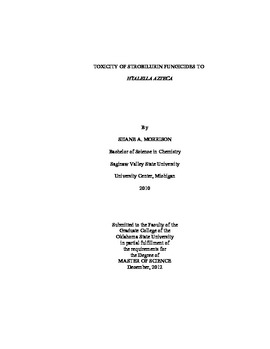| dc.description.abstract | Fungicide application rates on row crop agriculture have increased across the United States. As a result, contamination of adjacent aquatic systems can potentially occur through spray drift, unintentional direct spraying, or field runoff. To investigate the potential toxicity of the fungicides, the epibenthic aquatic amphipod Hyalella azteca was exposed to two common fungicide formulations Headline and Stratego and their individual active strobilurin ingredients. Water-only exposure studies for both formulations and active strobilurin ingredients resulted in LC50 values of 21 (18-25) for Headline, 25 (21-30) for pyraclostrobin, 20 (19-22) for Stratego, and 25 (18-38) g/L for trifloxystrobin, suggesting that toxicity is primarily due to the active strobilurin ingredient. When the fungicides were added to the overlying water of sediment/water microcosms, toxicity was reduced by 500% for Headline and 160% for Stratego as compared to water-only exposures, based on the total amount of fungicide added to the systems. Additionally, when fungicides were added to the sediment 24 h prior to the addition of water and amphipods, the reduction in toxicity was even greater, with no toxicity occurring at levels that would be environmentally relevant. Differences in toxicity among exposure groups were explained by dissipation from water as toxicity values based on measured water concentrations were within 20% between all systems. Although aquatic based LC50 values are below environmental concentrations that would likely occur following a direct overspray event into water (150 and 74 g/L for Headline and Stratego respectively), the presence of sediment in the system is likely to ameliorate some of the toxicity of fungicide formulations, especially if exposure to the wetland occurs prior to an inundation event. | |
